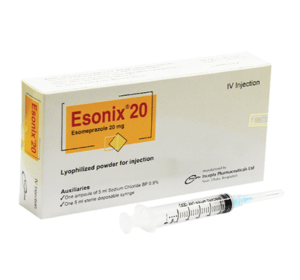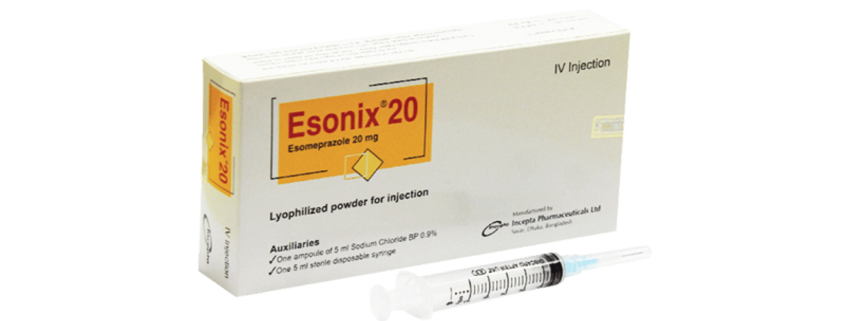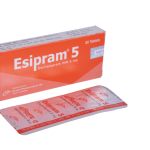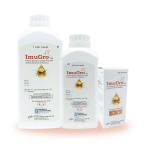Esonix(Esomeprazole)
Therapeutic Group: Gastro Intestinal Disorders

Presentation
Esonix 20 tablet: Each delayed release tablet contains Esomeprazole Magnesium Trihydrate BP equivalent to Esomeprazole 20 mg.
Esonix 40 tablet: Each delayed release tablet contains Esomeprazole Magnesium Trihydrate BP equivalent to Esomeprazole 40 mg.
Esonix 20 capsule: Each delayed release capsule contains Esomeprazole Magnesium Trihydrate BP equivalent to Esomeprazole 20 mg.
Esonix 40 capsule: Each delayed release capsule contains Esomeprazole Magnesium Trihydrate BP equivalent to Esomeprazole 40 mg.
Esonix 20 delayed-release oral suspension : Each sachet contains Esomeprazole Magnesium Trihydrate BP equivalent to Esomeprazole 20 mg.
Esonix 20 IV Injection: Each vial contains sterile lyophilized powder of Esomeprazole Sodium INN equivalent to Esomeprazole 20 mg.
Esonix 40 IV Injection: Each vial contains sterile lyophilized powder of Esomeprazole Sodium INN equivalent to Esomeprazole 40 mg.
Description
Esomeprazole (Esonix) is a proton pump inhibitor that suppresses gastric acid secretion by specific inhibition of the H+/K+ATPase in the gastric parietal cell. By acting specifically on the proton pump, Esonix blocks the final step in acid production, thus reducing gastric acidity.
Indications
Gastroesophageal Reflux Disease (GERD)
Healing of Erosive Esophagitis
Maintenance of Healing of Erosive Esophagitis
Symptomatic Gastroesophageal Reflux Disease
H. pylori Eradication to Reduce the Risk of Duodenal Ulcer Recurrence
Pathological Hypersecretory Conditions Including
Zollinger-Ellison Syndrome
Dosage & Administration
Gastroesophageal Reflux Disease (GERD)
Healing of Erosive Esophagitis: 20 mg or 40 mg Once Daily for 4 to 8 Weeks*
Maintenance of Healing of Erosive Esophagitis: 20 mg Once Daily
Symptomatic Gastroesophageal Reflux Disease: 20 mg Once Daily for 4 Weeks**
Pediatric GERD:
a) 12 to 17 Year Olds: Short-term Treatment of GERD 20 mg or 40 mg Once Daily for up to 8 Weeks
b) 1 to 11 Year Olds+: Short-term Treatment of Symptomatic GERD 10 mg Once Daily for up to 8 Weeks
Healing of Erosive Esophagitis:
a) weight <20 kg 10 mg Once Daily for 8 Weeks
b) weight ≥20 kg 10 mg or 20 mg Once Daily for 8 Weeks
Risk Reduction of NSAID-Associated Gastric Ulcer: 20 mg or 40 mg Once Daily for up to 6 months
H. pylori eradication to reduce the risk of Duodenal Ulcer recurrence:
Triple Therapy:
i) Esomeprazole 40 mg Once Daily for 10 Days
ii) Amoxicillin 1000 mg Twice Daily for 10 Days
iii) Clarithromycin 500 mg Twice Daily for 10 Days
Pathological Hypersecretory Conditions Including Zollinger-Ellison Syndrome: 40 mg Twice Daily
Injection
GERD with Erosive Esophagitis:
Adults: Dose is either 20 mg or 40 mg Esomeprazole given once daily by intravenous injection (not less than 3 minutes) or intravenous infusion (10
minutes to 30 minutes).
Pediatric: Give the following doses once daily as an intravenous infusion over 10 minutes to 30 minutes.
1 year to 17 years:
Body weight less than 55 kg: 10 mg
Body weight 55 kg or greater: 20 mg
1 month to less than 1 year of age: 0.5 mg/kg
Side Effects
In general, Esomeprazole was well tolerated in both short- and long-term clinical trials. The most frequently occurring adverse events (>1%) are headache and diarrhea. nausea, flatulence, abdominal pain, constipation and dry mouth occurred at similar rates among patients taking Esomeprazole.
Precautions
Symptomatic response to therapy with Esomeprazole does not preclude the presence of gastric malignancy. Atrophic gastritis has been noted occasionally in gastric corpus biopsies from patients treated long-term with omeprazole, of which Esomeprazole is an enantiomer.
Use in Pregnancy & Lactation
In Pregnancy: Pregnancy Category C. This drug should be used during pregnancy only if clearly needed.
In Lactation: The excretion of Esomeprazole in milk has not been studied. As Esomeprazole is likely to be excreted in human milk, a decision should be
made whether to discontinue nursing or to discontinue the drug, taking into account the importance of the drug to the mother.
Lactation: Esomeprazole is excreted in human milk. Thus, a decision should be taken to discontinue nursing or to discontinue the drug, taking into account the importance of the drug to the mother.
Drug Interaction
Drug interaction studies have shown that Esomeparzole does not have any clinically significant interactions with Phenytoin, Warfarin, Quinidine, Clarithromycin or Amoxicillin. Esomeprazole inhibits gastric acid secretion. Therefore, Esomeprazole may interfere with the absorption of drugs where gastric pH is an important determinant of bioavailability (eg, Ketoconazole, Iron salts and Dogoxin). Coadministration of oral contraceptives, Diazepam, Phenytoin or Quinidine did not seem to change the pharmacokinetic profile of Esomeprazole.
Over Dose
Drug interaction studies have shown that Esomeprazole does not have any clinically significant interactions with Phenytoin, Warfarin, Quinidine, Clarithromycin or Amoxicillin. Esomeprazole inhibits gastric acid secretion. Therefore, Esomeprazole may interfere with the absorption of drugs where
gastric pH is an important determinant of bioavailability (eg, Ketoconazole, Iron salts and Digoxin). Coadministration of oral contraceptives, Diazepam, Phenytoin or Quinidine did not seem to change the pharmacokinetic profile of Esomeprazole.
Commercial Pack
Esonix 20 tablet: Each box contains 7 Alu-Alu blister strips of 14 tablets.
Esonix 40 tablet: Each box contains 4 Alu-Alu blister strips of 14 tablets.
Esonix 20 capsule: Each box contains 7 Alu-Alu blister strips of 8 capsules.
Esonix 40 capsule: Each box contains 5 Alu-Alu blister strips of 6 capsules.
Esonix 20 delayed-release oral suspension: Each box contains 30 packets.
Esonix 20 IV Injection: Each box contains 1 vial of lyophilized Esomeprazole 20 mg, 1 ampoule of 5 ml 0.9% Sodium Chloride BP injection for intravenous injection and 1 sterile syringe (5 ml).
Esonix 40 IV Injection: Each box contains 1 vial of lyophilized Esomeprazole 40 mg, 1 ampoule of 5 ml 0.9% Sodium Chloride BP injection for intravenous injection and 1 sterile syringe (5 ml)
Others
*The majority of patients are healed within 4 to 8 weeks. For patients who do not heal after 4-8 weeks, an additional 4-8 weeks of treatment may be considered.
**If symptoms do not resolve completely after 4 weeks, an additional 4 weeks of treatment may be considered



